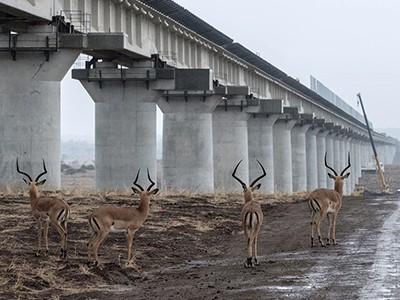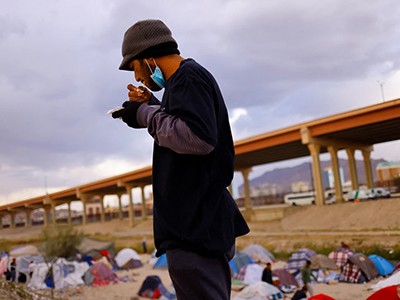For the past few years, US–China relations have been icy. We’ve witnessed spy balloons shot down, meetings cancelled, lines of communication severed and insults hurled from both sides of the Pacific. Yet, in recent weeks, there have been signs of a thaw. During the Asia-Pacific Economic Cooperation (APEC) Summit in California, US President Joe Biden and Chinese President Xi Jinping met for the first time in a year — and there was even talk of coexistence and cooperation.
Geopolitical observers tend to label this sort of moment as a reset. But another leader had started shifting the dial just a few weeks earlier: California’s Democratic governor Gavin Newsom. He did something that no US state governor has done in more than four years: he went to China. The focus of his visit was an issue of shared concern — the climate crisis.
Over history, the United States has been the world’s biggest greenhouse-gas emitter; China is the current largest. Flooding in Beijing and California earlier this year, and increasingly frequent wildfires in California, both thought to have been exacerbated by climate change, are reminders of what both parties can gain by finding solutions.
China’s Belt and Road Initiative is boosting science — the West must engage, not withdraw
Newsom’s mission was made possible by the relationships forged by previous California governors, including the Democrat Jerry Brown, who visited China in 2013 and 2017, and the Republican Arnold Schwarzenegger, who went in 2005. Among other initiatives, California shared its experience and expertise to help China to develop air-pollution management practices in Beijing and emissions cap-and-trade pilot programmes. Development began on a ‘green shipping corridor’ between the ports of Long Beach and Los Angeles in California and Shanghai in China.
I accompanied Brown to China in 2017. With my colleagues from the California–China Climate Institute, an initiative launched in 2019 at the University of California, Berkeley, I tapped that experience to help Newsom’s team this time. Our efforts led to a series of high-level meetings between Newsom and Chinese leaders, culminating in a meeting with Xi. During the meeting, Xi emphasized three words: ‘cherish’, to acknowledge Newsom’s rational voice and good intentions; ‘inclusive’ to recognize the importance of people, youth and sub-national entities in US–China exchanges; and ‘potential’, to affirm the power of climate cooperation in shaping future relations.
Newsom used the trip to build on existing memoranda of understanding between California and China’s Ministry of Ecology and Environment and Hainan province, adding agreements with the National Development and Reform Commission, as well as with the cities of Beijing and Shanghai and with Guangdong and Jiangsu provinces. These agreements focus on everything from joint efforts to decarbonize the power and industrial sectors and deploy more clean-energy technologies, especially offshore wind projects and zero-emission vehicles, to spurring cooperation around climate adaptation and resilience.
My institute also co-hosted the Great Wall Climate Dialogue to facilitate information exchange between government officials, universities and think tanks. This helped to identify opportunities for joint research on regional climate policy; strategies to reduce non-carbon-dioxide greenhouse-gas emissions, for example using remote sensing to detect methane leakage from power plants and waste landfills; climate adaptation and resilience in coastal regions; and the nexus between climate change, air quality and public health. A first-of-its-kind commitment between China and a sub-national government — the Declaration of Enhanced Subnational Climate Action and Cooperation Between the State of California and the People’s Republic of China — pledged cooperation on cutting greenhouse-gas emissions and transitioning away from fossil fuels.
What scientists need to do to accelerate progress on the SDGs
How to implement these agreements must now be the focus. Agencies and departments in California and China will need to facilitate further exchanges, initiate work plans, form working groups and take advantage of global climate gatherings such as the COP28 climate summit, starting in Dubai next week, to continue discussions.
There is huge potential for cooperation on initiatives such as the Hainan Carbon Peaking Implementation Plan, which aims to demonstrate how transportation decarbonization can be achieved through incentives, sufficient infrastructure and strong electric-vehicle deployment targets. On methane mitigation, a project in Shanghai to reduce emissions from rice cultivation and a pilot programme in Guangdong province of landfill methane reduction are being paired with projects in California. On wind energy, demonstration projects at Yancheng in Jiangsu province will serve as a benchmark for the development of offshore wind projects along California’s coast. On sustainable and green shipping, partnerships are being expanded beyond the green shipping corridor already in development to include more ports in China and northern California.
These initiatives serve as a reminder that, despite differences and challenges, there is not only an opportunity, but also an imperative for China and the United States to work together. This trip also affirmed the part that sub-national governments can play in “delivering real climate action and creating opportunities for future cooperation”, as Newsom put it. Such initiatives, and what comes next in Sacramento, Washington DC and Beijing, could be crucial for a breakthrough on climate action.


 Major US climate disasters occur every three weeks, report finds
Major US climate disasters occur every three weeks, report finds
 Earth just had its hottest year on record — climate change is to blame
Earth just had its hottest year on record — climate change is to blame
 How Beijing’s deadly floods could be avoided
How Beijing’s deadly floods could be avoided
 China’s Belt and Road Initiative is boosting science — the West must engage, not withdraw
China’s Belt and Road Initiative is boosting science — the West must engage, not withdraw
 Scientists call out rogue emissions from China at global ozone summit
Scientists call out rogue emissions from China at global ozone summit
 What scientists need to do to accelerate progress on the SDGs
What scientists need to do to accelerate progress on the SDGs







